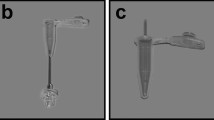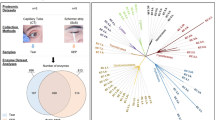Abstract
A MAJOR, poorly characterized component of human tears migrates more anodally than serum albumin in electrophoresis1. Erickson termed this protein “tear albumin”. When they carried out immunoelectrophoresis of human tears with rabbit anti-human tear serum, Josephson and Lockwood2,3 obtained a precipitin line in the albumin region. This line did not disappear when the anti-tear serum was absorbed with normal human serum. These results1–3 did not exclude the possibility that the tear albumin was a modified form of the albumin or prealbumin found in serum, as was the case with secretory IgA, which consists of serum IgA attached to a “transport piece”4.
This is a preview of subscription content, access via your institution
Access options
Subscribe to this journal
Receive 51 print issues and online access
$199.00 per year
only $3.90 per issue
Buy this article
- Purchase on Springer Link
- Instant access to full article PDF
Prices may be subject to local taxes which are calculated during checkout
Similar content being viewed by others
References
Erickson, O. F., Stanford Med. Bull., 14, 125 (1956).
Josephson, A. S., and Lockwood, D. W., J. Immunol., 93, 532 (1964).
Josephson, A. S., and Wiener, S. R., J. Immunol., 100, 1080 (1968).
Tomasi, jun., T. B., Tan, E. M., Solomon, A., and Prendergast, R. A., J. Exp. Med., 121, 101 (1965). South, M. A., Cooper, M. D., Wollheim, F. A., Hong, R., and Good, R. A., ibid., 123, 615 (1966).
Erickson, O. F., Halten, R., and Berg, M., Amer. J. Ophthalmol., 47, 499 (1959). Allerhand, J., Karelitz, S., Isenberg, H. D., Penbharkkul, S., and Ramos, A., J. Pediatrics, 62, 234 (1963).
Cohn, E. J., Hughes, W. L., and Weare, J. H., J. Amer. Chem. Soc., 69, 1753 (1947).
Schultze, H. E., Schonenberger, M., and Schwick, G., Biochem. Z., 328, 267 (1956).
Sophianopoulos, J. A., Rhodes, K. C., Holcomb, N. D., and van Holde, E. K., J. Biol. Chem., 237, 1107 (1962).
Bonavida, B., Sapse, A. T., and Sercarz, E. E., Invest. Ophthalmol., 7, 435 (1968).
Schultze, H. E., and Heremans, J. F., Molecular Biology of Human Proteins, 589 (Elsevier, Amsterdam, 1966).
McEwen, W. K., Kimura, S. G., and Feeney, M. L., Amer. J. Ophthalmol., 45, 158 (1957).
Erickson, O. F., Stanford Med. Bull., 13, 292 (1955).
Erickson, O. F., and Hatlen, R., Amer. J. Ophthalmol., 47, 499 (1959); 45, 117 (1958).
Sapse, A. T., Bonavida, B., Stone, jun., W., and Sercarz, E. E., Amer. J. Ophthalmol., 66, 76 (1968).
Author information
Authors and Affiliations
Rights and permissions
About this article
Cite this article
BONAVIDA, B., SAPSE, A. & SERCARZ, E. Specific Tear Prealbumin: a Unique Lachrymal Protein absent from Serum and other Secretions. Nature 221, 375–376 (1969). https://doi.org/10.1038/221375a0
Received:
Revised:
Issue Date:
DOI: https://doi.org/10.1038/221375a0
This article is cited by
-
Tear ferning and other lacrimal tests in normal persons of different ages
International Ophthalmology (1991)
-
Effective methods for the investigation of human tear film proteins and lipids
Graefe’s Archive for Clinical and Experimental Ophthalmology (1990)
-
A polyacrylamide-gel electrophoretic study of human tear proteins
Graefe's Archive for Clinical and Experimental Ophthalmology (1982)
-
Proteins in tears from healthy and diseased eyes
Documenta Ophthalmologica (1980)
Comments
By submitting a comment you agree to abide by our Terms and Community Guidelines. If you find something abusive or that does not comply with our terms or guidelines please flag it as inappropriate.



